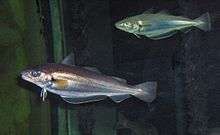Merlangius
| Merlangius merlangus | |
|---|---|
 | |
| Scientific classification | |
| Kingdom: | Animalia |
| Phylum: | Chordata |
| Class: | Actinopterygii |
| Order: | Gadiformes |
| Family: | Gadidae |
| Genus: | Merlangius Garsault, 1764 |
| Species: | M. merlangus |
| Binomial name | |
| Merlangius merlangus (Linnaeus, 1758) | |
| Synonyms | |
|
Gadus merlangus Linnaeus, 1758 | |
Merlangius merlangus, commonly known as whiting or merling, is an important food fish in the eastern North Atlantic Ocean and the northern Mediterranean, western Baltic, and Black Seas. In English-speaking countries outside the whiting's natural range, the name has been applied to various other species of fish.
Description
Merlangius merlangus has three dorsal fins with a total of 30 to 40 soft rays and two anal fins with 30 to 35 soft rays. The body is long and the head small and a chin barbel, if present, is very small. This fish can reach a maximum length of about 70 cm (27.5 in). The colour may be yellowish-brown, greenish or dark blue, the flanks yellowish grey or white and the belly silvery. There is a distinctive black blotch near the base of each pectoral fin.[1]
Distribution and habitat
Whiting are native to the northeastern Atlantic Ocean. Their range extends from the southeastern Barents Sea and Iceland to Scandinavia, the Baltic Sea, the North Sea, Portugal, the Black Sea, the Aegean Sea, the Adriatic Sea and parts of the Mediterranean Sea. They occur on sand, mud and gravel seabeds at depths down to about 100 m (328 ft).[1]
In 2014, their conservation status was classified at vulnerable in the Baltic Sea.[2]
Uses
Until the late 20th century, whiting was a cheap fish, regarded as food for the poor or for pets.[3] Whiting was also allegedly used as a filler in flour, beit wheat, barley or rye. In times of shortages, particularly in the eighteenth century, millers and bakers were commonly accused of using ground whiting to cut their flour as the costs of the fish was lower than that of the actual grain.[4] The general decline in fish stocks means it is now more highly valued. The other fish that have been given the name whiting are mostly also edible fish. Several species of the drum, or croaker, family (Sciaenidae) are also called whiting, among them the northern kingfish (Menticirrhus saxatilis).
Parasites
Whiting and related cod species are plagued by parasites. These include the cod worm, Lernaeocera branchialis, a copepod crustacean that clings to the gills or the fish and metamorphoses into a plump, sinusoidal, wormlike body, with a coiled mass of egg strings at the rear.
References
- 1 2 "Merlangius merlangus (Linnaeus, 1758): Whiting". FishBase. Retrieved 2013-12-20.
- ↑ HELCOM (2013). "HELCOM Red List of Baltic Sea species in danger of becoming extinct" (PDF). Baltic Sea Environmental Proceedings (140): 72.
- ↑ "Whiting". www.BritishSeaFishing.co.uk. Retrieved 14 December 2014.
- ↑ James Manning, The Nature of Bread, Honestly and Dishonestly Made; and Its Effects as Prepared at present On Unhealthy and Healthy Persons (London, 1757)
- "Merlangius merlangus". Integrated Taxonomic Information System. Retrieved 19 March 2006.
